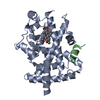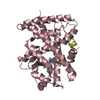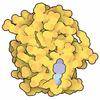登録情報 データベース : PDB / ID : 4y29タイトル Identification of a novel PPARg ligand that regulates metabolism Peptide from Nuclear receptor coactivator 1 Peroxisome proliferator-activated receptor gamma キーワード / / / / / / / / / / / 機能・相同性 分子機能 ドメイン・相同性 構成要素
/ / / / / / / / / / / / / / / / / / / / / / / / / / / / / / / / / / / / / / / / / / / / / / / / / / / / / / / / / / / / / / / / / / / / / / / / / / / / / / / / / / / / / / / / / / / / / / / / / / / / / / / / / / / / / / / / / / / / / / / / / / / / / / / / / / / / / / / / / / / / / / / / / / / / / / / / / / / / / / / / / / / / 生物種 Homo sapiens (ヒト)手法 / / / 解像度 : 1.98 Å データ登録者 Wang, R. / Li, Y. 資金援助 組織 認可番号 国 National Natural Science Foundation of China 31270776
ジャーナル : Sci Rep / 年 : 2015タイトル : Selective targeting of PPAR gamma by the natural product chelerythrine with a unique binding mode and improved antidiabetic potency.著者 : Zheng, W.L. / Qiu, L. / Wang, R. / Feng, X.H. / Han, Y.P. / Zhu, Y.L. / Chen, D.Z. / Liu, Y.J. / Jin, L.H. / Li, Y. 履歴 登録 2015年2月9日 登録サイト / 処理サイト 改定 1.0 2015年9月9日 Provider / タイプ 改定 1.1 2023年11月8日 Group Data collection / Database references ... Data collection / Database references / Derived calculations / Refinement description カテゴリ chem_comp_atom / chem_comp_bond ... chem_comp_atom / chem_comp_bond / database_2 / pdbx_initial_refinement_model / pdbx_struct_oper_list Item / _database_2.pdbx_database_accession / _pdbx_struct_oper_list.symmetry_operation
すべて表示 表示を減らす
 データを開く
データを開く 基本情報
基本情報 要素
要素 キーワード
キーワード 機能・相同性情報
機能・相同性情報 Homo sapiens (ヒト)
Homo sapiens (ヒト) X線回折 /
X線回折 /  シンクロトロン /
シンクロトロン /  分子置換 / 解像度: 1.98 Å
分子置換 / 解像度: 1.98 Å  データ登録者
データ登録者 中国, 1件
中国, 1件  引用
引用 ジャーナル: Sci Rep / 年: 2015
ジャーナル: Sci Rep / 年: 2015 構造の表示
構造の表示 Molmil
Molmil Jmol/JSmol
Jmol/JSmol ダウンロードとリンク
ダウンロードとリンク ダウンロード
ダウンロード 4y29.cif.gz
4y29.cif.gz PDBx/mmCIF形式
PDBx/mmCIF形式 pdb4y29.ent.gz
pdb4y29.ent.gz PDB形式
PDB形式 4y29.json.gz
4y29.json.gz PDBx/mmJSON形式
PDBx/mmJSON形式 その他のダウンロード
その他のダウンロード 4y29_validation.pdf.gz
4y29_validation.pdf.gz wwPDB検証レポート
wwPDB検証レポート 4y29_full_validation.pdf.gz
4y29_full_validation.pdf.gz 4y29_validation.xml.gz
4y29_validation.xml.gz 4y29_validation.cif.gz
4y29_validation.cif.gz https://data.pdbj.org/pub/pdb/validation_reports/y2/4y29
https://data.pdbj.org/pub/pdb/validation_reports/y2/4y29 ftp://data.pdbj.org/pub/pdb/validation_reports/y2/4y29
ftp://data.pdbj.org/pub/pdb/validation_reports/y2/4y29
 リンク
リンク 集合体
集合体
 要素
要素 Homo sapiens (ヒト) / 遺伝子: PPARG, NR1C3 / プラスミド: pET24 / 発現宿主:
Homo sapiens (ヒト) / 遺伝子: PPARG, NR1C3 / プラスミド: pET24 / 発現宿主: 
 Homo sapiens (ヒト) / 参照: UniProt: Q15788
Homo sapiens (ヒト) / 参照: UniProt: Q15788 X線回折 / 使用した結晶の数: 1
X線回折 / 使用した結晶の数: 1  試料調製
試料調製 シンクロトロン / サイト:
シンクロトロン / サイト:  SSRF
SSRF  / ビームライン: BL17U / 波長: 1.005 Å
/ ビームライン: BL17U / 波長: 1.005 Å 解析
解析 分子置換
分子置換 ムービー
ムービー コントローラー
コントローラー

















 PDBj
PDBj














